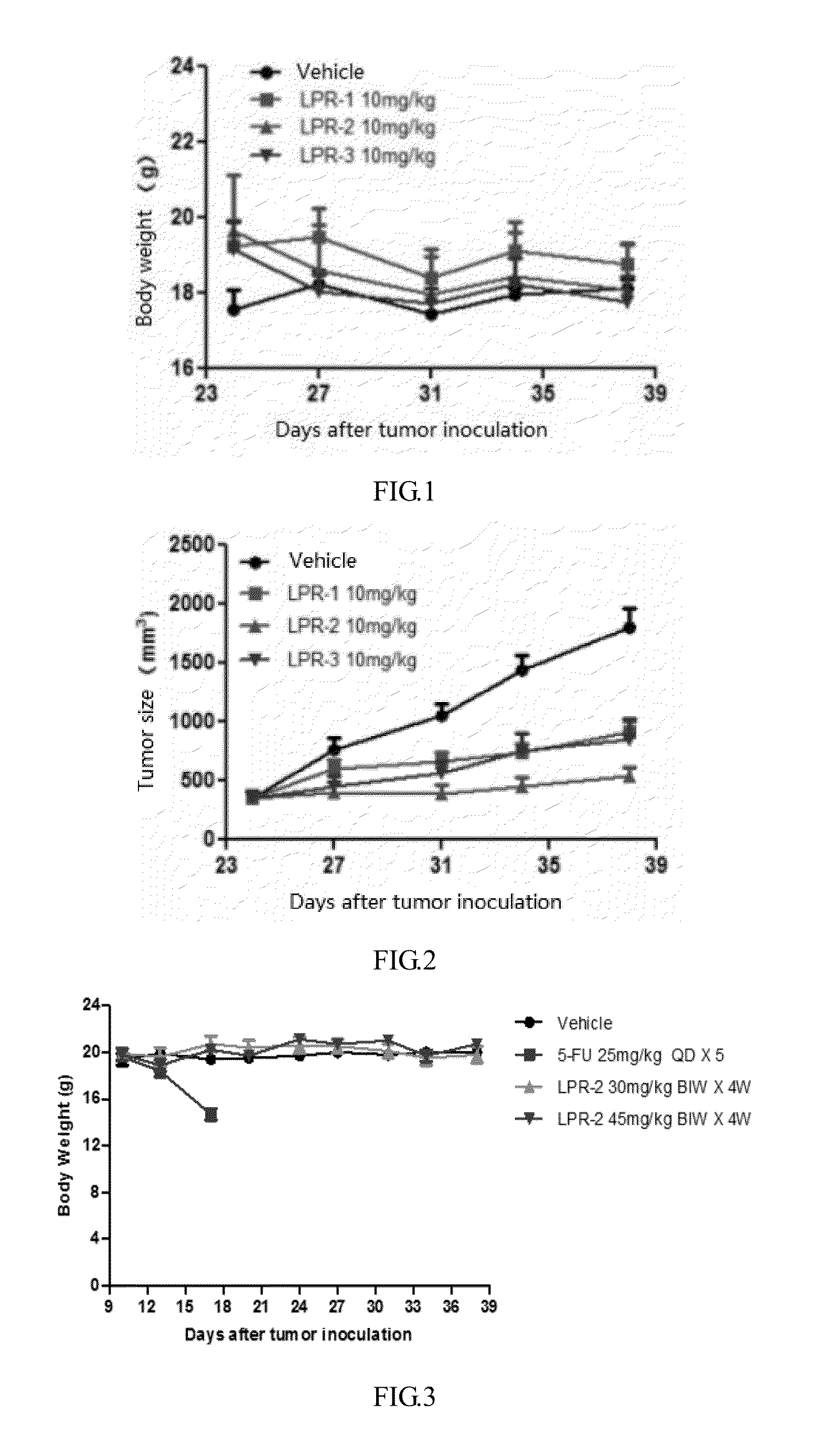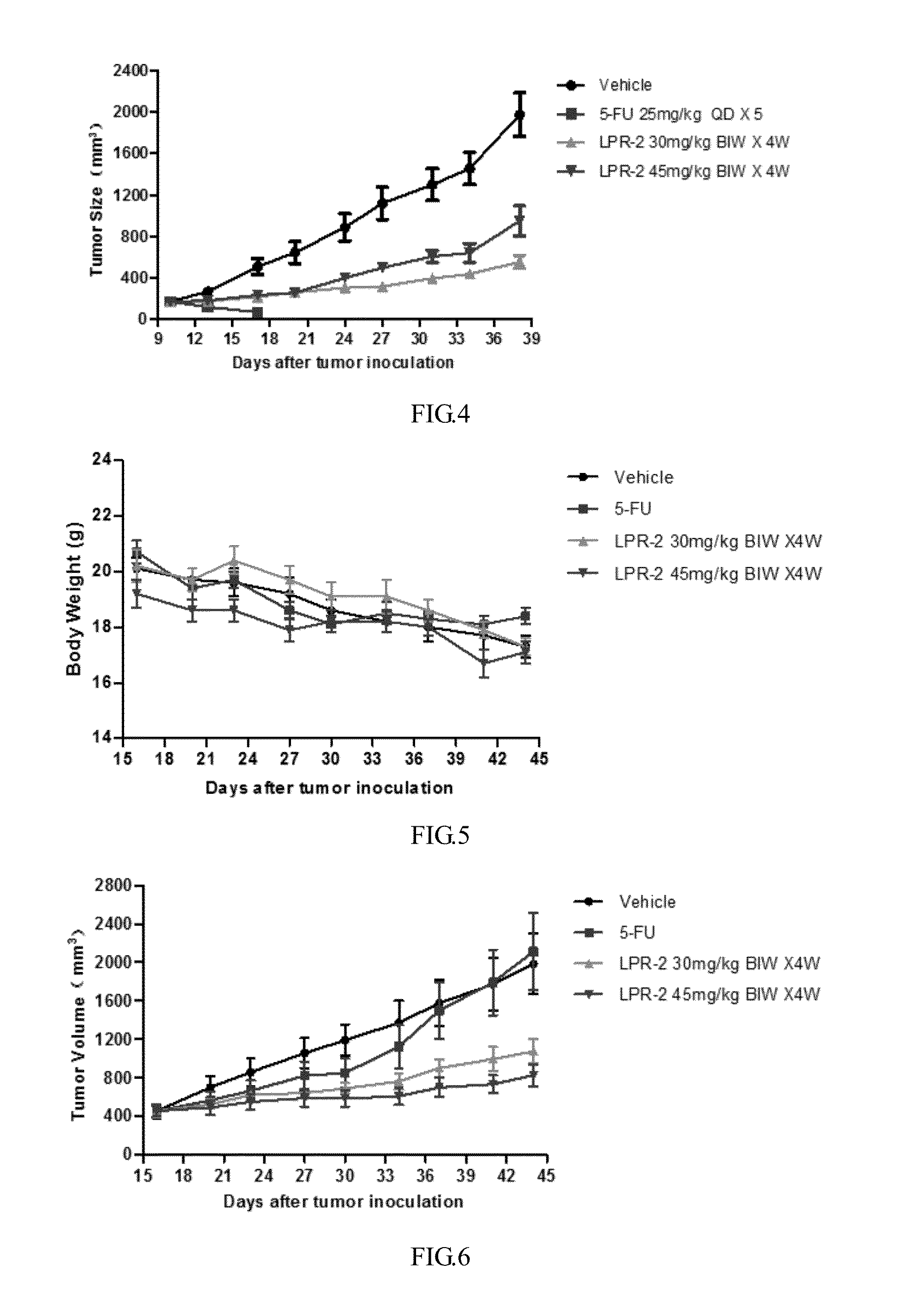Polyethylene glycol-cactus oligopeptide bonding rapamycin derivatives
a technology of polyethylene glycol and cactus, which is applied in the field of polyethylene glycol cactus oligopeptide bonding rapamycin derivatives, can solve the problems of poor oral bioavailability of everolimus, poor drug composition, and poor drug loading rate, and achieves reduced preparation specifications, increased drug loading rate, and improved drug loading rate
- Summary
- Abstract
- Description
- Claims
- Application Information
AI Technical Summary
Benefits of technology
Problems solved by technology
Method used
Image
Examples
example 1
Preparation of Glycine Ester of Rapamycin
[0099]
[0100]Tert-butyl bromoacetate (5.82 g, 30 mmoL) was added to the reaction flask and dissolved by acetone (80 mL), a solution obtained by sodium azide (4.55 g, 70 mmoL) dissolved in water (40 mL) was then added, the mixture obtained was heated and refluxed overnight. Acetone was distilled off the reaction solution, the residue was extracted with ether, the extract obtained was washed by saturated brine, dried and concentrated under reduced pressure to give an oily liquid. This liquid was dissolved by methanol (90 mL) and added by 1 N of sodium hydroxide solution (90 mL), stirred, heated and refluxed for 3 h. After being cooled, methanol was distilled off under reduced pressure, the residue was cooled by an ice bath and added by 6 N of hydrochloric acid to adjust the value of pH to 2, and then extracted with ether, the extract obtained was washed by water, dried, and concentrated to give azidoacetic acid, MS m / z: 124 [M+Na]+.
[0101]Azidoac...
example 2
Preparation of Monomethoxy Polyethylene Glycol (With a Number Average Molecular Weight of 20,000)-Rapamycin Conjugate (LPR-1)
[0103]
[0104]Monomethoxy polyethylene glycol acetic acid (20 K, 1 g, 0.05 mmoL), glycine ester of rapamycin (97 mg, 0.1 mmoL) prepared in Example 1, 1-hydroxy benzotriazole(HOBt, 6.8 mg, 0.05 mmoL) and DMAP (12.2 mg, 0.1 mmoL) were added to the reaction flask, dissolved with dichloromethane, cooled by an ice bath, then added dropwise by a solution obtained by DCC (15.5 mg, 0.075 mmoL) dissolved in dichloromethane, warmed to room temperature naturally after the dropping, the reaction was kept overnight, the next day the reaction solution was concentrated and the residue was crystallized with isopropanol to give 0.82 g of monomethoxy polyethylene glycol (20 K)-rapamycin conjugate (LPR-1) (n is about 450).
[0105]1H-NMR (300 MHz, CDCl3): 0.90 (Me, 3H, 43), 0.92 (Me, 3H, 49), 0.94 (Me, 3H, 46), 0.96 (Me, 3H, 48), 0.97 (Me, 3H, 45), 1.10 (CH2, 2H, 24), 1.11 (CH2, 2H, ...
example 3
Preparation of Monomethoxy Polyethylene Glycol (With a Number Average Molecular Weight of 20,000)-glutamic acid dipeptide-rapamycin conjugate (LPR-2)
[0106]
[0107]Monomethoxy polyethylene glycol-glutamic acid dipeptide (20 K, 0.5 g, 0.025 mmol), glycine ester of rapamycin 48.6 mg (0.05 mmoL) prepared in Example 1, HOBt (3.4 mg, 0.025 mmoL) and DMAP 6.1 mg (0.05 mmoL) were added to the reaction flask, dissolved with dichloromethane, cooled by an ice bath, then added dropwise by a solution obtained by DCC 15.5 mg (0.075 mmoL) dissolved in dichloromethane, warmed to room temperature naturally after the dropping, the reaction was kept overnight. The next day the reaction solution was concentrated and the residue was crystallized with isopropanol to give 0.41 g of monomethoxy polyethylene glycol (20K)-glutamic acid dipeptide-rapamycin conjugate (LPR-2) (n is about 450).
[0108]1H-NMR (300 MHz, CDCl3): 0.90 (Me, 9H, 43), 0.92 (Me, 9H, 49), 0.94 (Me, 9H, 46), 0.96 (Me, 9H, 48), 0.97 (Me, 9H, 4...
PUM
| Property | Measurement | Unit |
|---|---|---|
| molecular weight | aaaaa | aaaaa |
| molecular weight | aaaaa | aaaaa |
| melting point | aaaaa | aaaaa |
Abstract
Description
Claims
Application Information
 Login to View More
Login to View More - R&D
- Intellectual Property
- Life Sciences
- Materials
- Tech Scout
- Unparalleled Data Quality
- Higher Quality Content
- 60% Fewer Hallucinations
Browse by: Latest US Patents, China's latest patents, Technical Efficacy Thesaurus, Application Domain, Technology Topic, Popular Technical Reports.
© 2025 PatSnap. All rights reserved.Legal|Privacy policy|Modern Slavery Act Transparency Statement|Sitemap|About US| Contact US: help@patsnap.com



